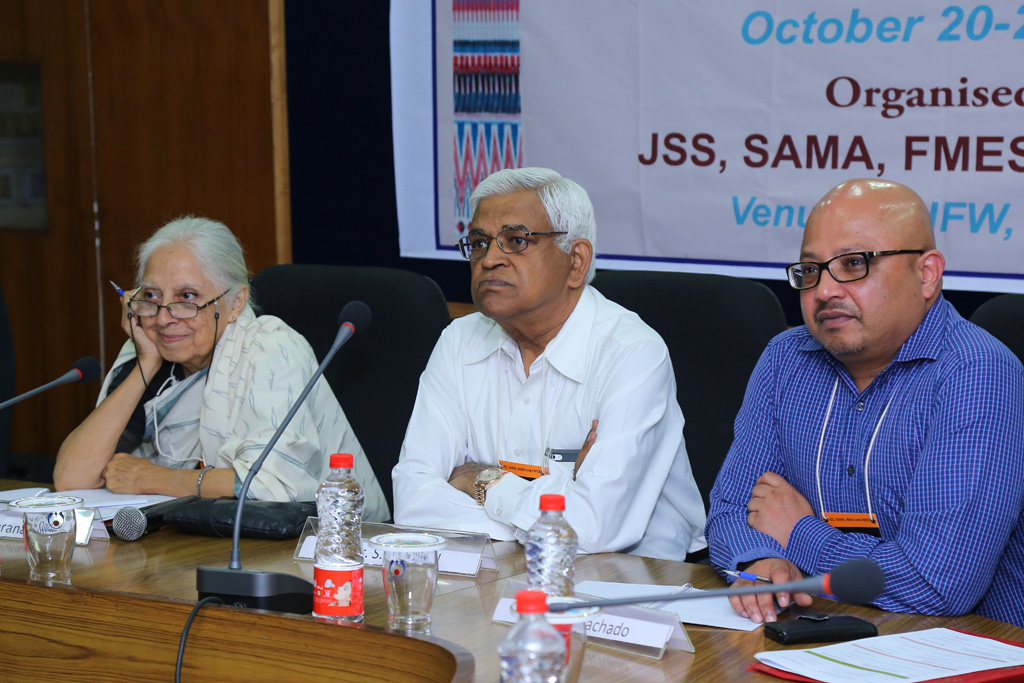
Dr. S. K. Mittal (Max Hospital, ex-MAMC), Dr. Jacob Puliyel (St. Stephen’s Hospital), and Dr. L. Machado (WHO) presented on safety profile of vaccines, adverse events following immunisation (AEFI), and on inclusion of new vaccines in UIP.
- The literature on vaccines is mostly positive, and does not focus much on safety and efficacy issues. Any negative aspects associated with vaccines are relegated to the margins of the discourse.
- Vaccines can have side effects, but it is difficult to establish a causal relation between administration and vaccine reaction. Post vaccine surveillance is very important but large companies are unwilling to set up such processes; only through reports or stray reports do we get any idea of what is happening.
- The rotavirus vaccine was discussed; extensive epidemiological data exists that diarrhoea is a major cause of death. However, rotavirus vaccine is not a solution for diarrhoea. The serotypes keep changing. The Rotavirus vaccine thus has limited impact on infant mortality rate (IMR).Even with 100 percent coverage, prevention is only eight percent. Studies exist that show that indigenous Rotavirus Vaccine has 60 percent efficacy; however, some research papers on it were sponsored by Glaxo SmithKline (GSK), the pharmaceutical manufacturer. In one paper, 26 of 27 authors declared conflict of interest as they had connections with GSK.
- Robust and mandatory norms and mechanisms for reporting and investigating, vaccine injury prevention and compensation should be put in place.
- The case that was highlighted during the discussions was of three Pentavalent deaths in Sri Lanka, following which the WHO deleted the criteria of “probable” and “possible” and declared that the deaths were not related to the vaccines from the Council for International Organisations of Medical Sciences (CIOMS)/WHO guidelines.
- Concerns were raised regarding the guidelines in which a case of AEFI was turned into non-AEFI, even though it shows possible or probable link for causality. The former “probability” scale to assess causality for investigating an AEFI included six criteria – “certain”, “possible”, “probable”, “unlikely”, “unrelated”, and “unclassifiable”.
- This scale has been revised to strike off “possible” and “probable”, raising concerns over flaws in the investigation of AEFI. The guidelines mentions that an event can be called an AEFI only if a similar event is proven in previous epidemiological studies. The new algorithm devised under CIOMS/WHO guidelines and the AEFI, which was not noticed in epidemiological studies previously, will be deleted, such that there will be no record of them and thus they cannot be investigated. The challenge is to remove the obfuscation surrounding the investigation of AEFI.
- There have been deaths and serious adverse events (SAEs) following the Pentavalent vaccine. The evidence is with the government, but is not being made public. The paediatricians are using this vaccine, as they believe they are helping children. But, the AEFI are not taken seriously.
- The representative from WHO, while speaking on AEFI causality assessment protocol shared existing challenges in following up on adverse event. There are challenges in collecting data from the field and there is need to understand the ground realities. Every block primary health centre (PHC) has a reporting mechanism in place for AEFI. The WHO is trying to help medical officers to collect the information in as detailed a manner as possible. Causality assessment is done at the state level, not at the district level.
- 670 out of 683 odd districts have district AEFI committees. Some limitations exist in both government and private hospitals, such as staffing, documentation gaps, etc., in terms of implementation of the protocol.
- It is a now a mechanical process, with an eligibility criteria to determine if the AEFI satisfies the minimum criteria for causality assessment. The checklist systematically review the available information and algorithms are use to obtain a trend in causality.
- Unfortunately, where there is prior evidence the approval if the vaccine is fast tracked, and waiver of phase III clinical trials maybe given by the Drug Controller General of India (DCGI). However, careful assessment needs to be done, prior to granting waiver. The AEFI is not just a statistical number, but needs to be taken seriously, and the definition
needs to change.
Highlights from the Seminar Sessions
Session I: Present Status of Children’s Health and Vaccination
Session II: Prioritisation of Interventions for Disease Prevention
Session III: Inclusion of new vaccine in the UIP: How effective are new vaccines?
Session IV: Inclusion of new vaccine in the UIP: Risk assessment and safety of vaccine
Session V: Ethics and Regulations
Session VI: Inclusion of new vaccine in the UIP: Cost effectiveness and Financial issues
Session VII: Inclusion of New Vaccines in the UIP: Health System Preparedness
Recommendations
Annexures
Annexure 1: Background Note of the Seminar
Annexure 2: Seminar Schedule
Annexure 3: Organisers of the Seminar
Annexure 4: List of Participants




